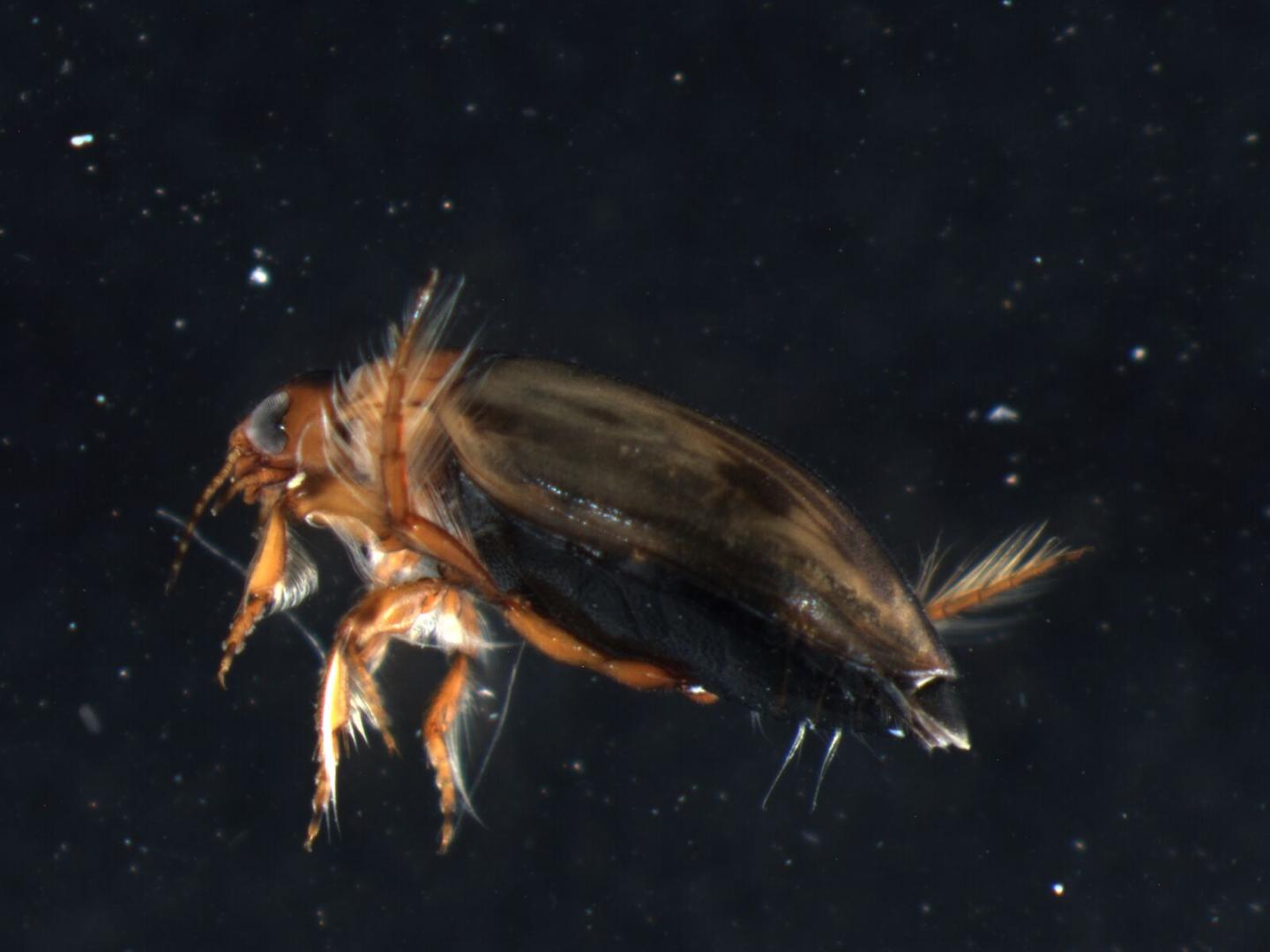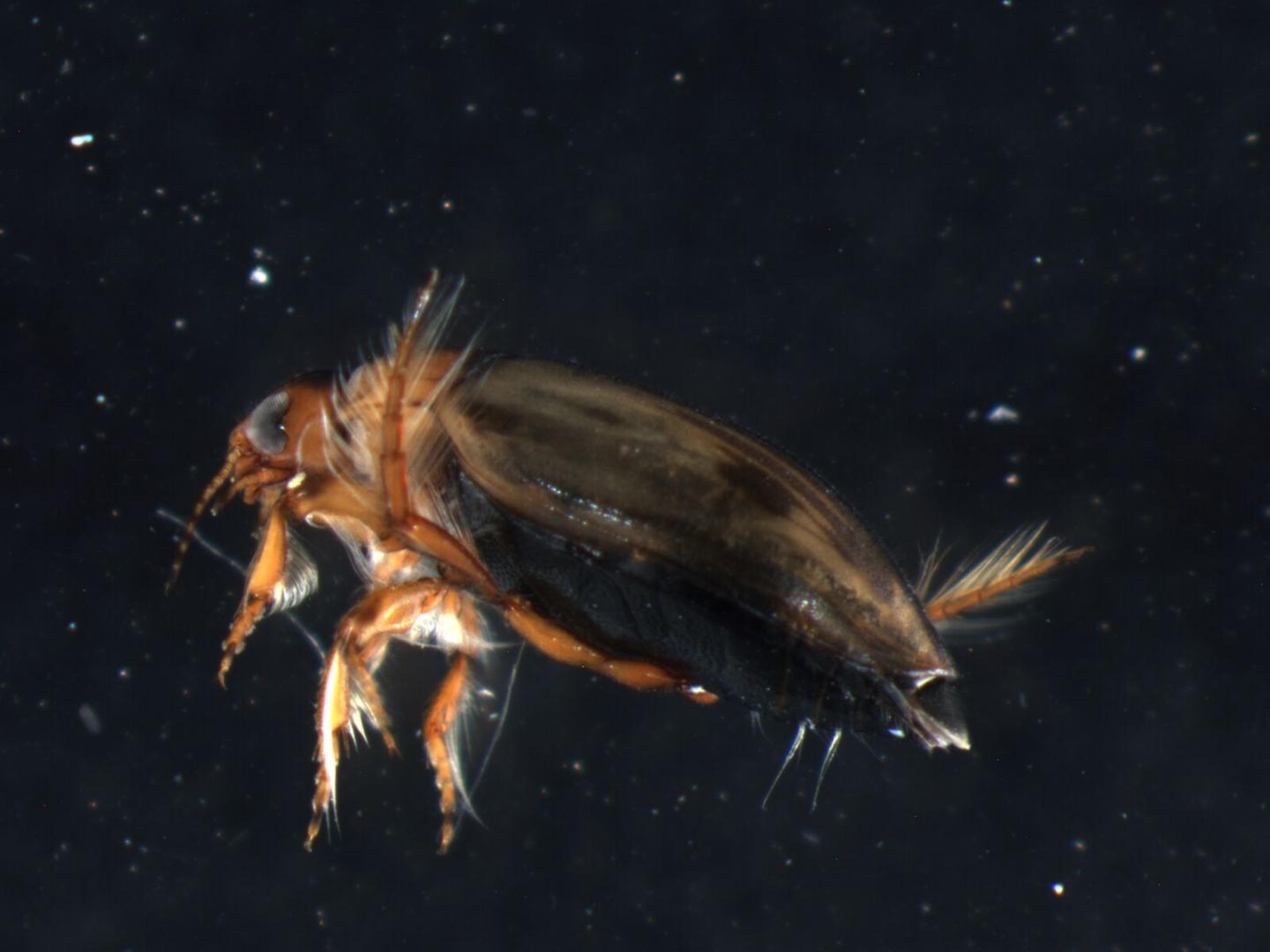
Credit: Lusha Tronstad
University of Wyoming researchers are shedding light on a rare aquatic beetle native only to central Wyoming.
Lusha Tronstad, lead invertebrate zoologist with the Wyoming Natural Diversity Database, a service and research unit housed at UW, says the narrow-footed Hygrotus diving beetle has been petitioned for Endangered Species Act listing three times in the past 11 years by Wild Earth Guardians, an activist group.
"We have no idea how many there are," Tronstad says of the aquatic beetle she has studied since 2010. "We do know they have been found in 12 locations in central Wyoming and nowhere else in the world."
Tronstad was lead author of a paper, titled "Using Species Distribution Models to Guide Field Surveys for an Apparently Rare Aquatic Beetle," that was published June 4 (today) in the online version of the Journal of Fish and Wildlife Management and is expected to be in print later this month. The journal publishes manuscripts containing information from original research that contributes to basic wildlife science. Topics include investigations into the biology and ecology of wildlife and their habitats that have direct or indirect implications for wildlife management and conservation.
Kelsey Brown, a graduate student in UW's Department of Ecosystem Science and Management, and Mark Andersen, information systems and services coordinator for the Wyoming Natural Diversity Database, were co-authors of the paper.
Andersen created species distribution models, using such variables as how much sagebrush cover was available; soil conductivity, or how salty the soil is; air temperatures; and depth of groundwater at the sites.
"We used thesis models to predict suitable habitat for the beetles," Tronstad says. "Using model results, we surveyed new sites across the state and discovered the beetle at one new location."
This aquatic beetle was first discovered by Hugh Leech, a beetle expert, in 1964. Leech was driving along old Highway 85 near Midwest, according to Tronstad.
"He stopped and sampled Dugout Creek. Voila. He discovered a new species and published his work in 1966," Tronstad says.
The known range of the diving beetle, which also can fly, is in central Wyoming, in the Powder River Basin and one site in the Wind River Basin. A site near Kaycee is the newest location where these insects have been discovered. The sites are small, intermittent streams with disconnected pools and contain high concentrations of salt. These streams are in shortgrass prairie ecosystems that receive less than 400 millimeters of precipitation each year, much of which is snow during spring.
Roughly 2.5 millimeters long, they are predators, feeding on mayflies, midges and other types of insects. Males are distinguished by large biceps on their front legs. They hibernate in the winter and reproduce during the summer, says Tronstad, who has conducted annual surveys of eight of the 12 known sites since 2010.
Aquatic beetles were collected in 2010, 2011 and 2012 to estimate the current distribution of the diving beetle in Wyoming, Tronstad says. Three streams — Dugout Creek, Dead Horse Creek and two locations in Cloud Creek — in the Powder River Basin were surveyed in July 2010. Tronstad says the group monitored statewide in 2011 and 2012. The group visited 511 sites and collected invertebrates from 246 sites over two summers.
"I usually walk up and down the streams," Tronstad says of her summer research routine. "I sometimes find one stream where the beetle is living or a couple of streams."
And, how do these beetles survive in these streams, which have a high concentration of salt?
"My guess is they can outcompete other invertebrates in these harsh, intermittent streams because they're very, very salty," Tronstad surmises. "The salts in the water make it difficult for other invertebrates to survive. Salt dehydrates. We think they have special mechanisms to deal with the salt."
Models created predicted the diving beetles were more likely to be found in intermittent streams with a gentle gradient; shallow water table; variable precipitation patterns; high soil electrical conductivity; and in the warmest places in Wyoming.
"These streams will dry up into puddles during the summer," she explains. "If we didn't have any shallow groundwater in these intermittent streams, there probably wouldn't be any habitat for them."
Results suggest that maintaining the hydrologic integrity of prairie streams in Wyoming is vital to the conservation of the diving beetle, the paper says.
"What I will be doing next is looking at these finer variables to find out what is limiting their distribution," Tronstad says. "I will be collecting information on cattle grazing and oil and gas, and how that might affect the sites."
###
Media Contact
Lusha Tronstad
[email protected]
307-766-3115
http://www.uwyo.edu
Original Source
http://www.uwyo.edu/uw/news/2018/06/uw-researchers-study-aquatic-beetles-native-only-to-central-wyoming.html http://dx.doi.org/10.3996/112016





